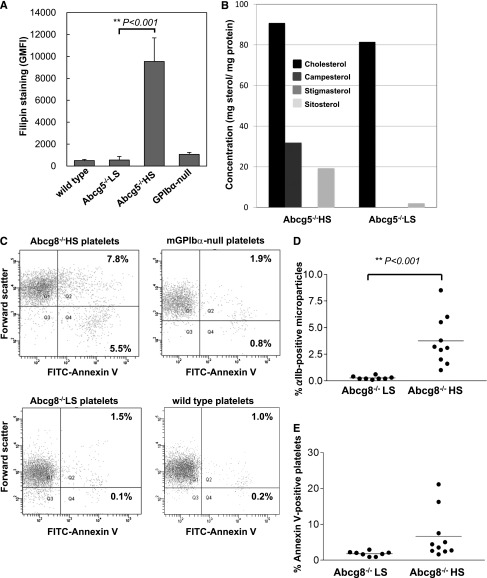Figure 2.
Sterol accumulation and increased platelet-derived microparticle (PMP) generation in sitosterolemic mouse platelets. (A) Whole blood samples were stained with phycoerythrin (PE)-conjugated anti-mouse αIIb mAb and platelet fraction was identified by αIIb positivity and forward-side scatter. Platelets from Abcg5−/− HS become large and are compared with GPIb-deficient (Bernard Soulier) platelets, which exhibit αIIb positivity in a larger forward-side scatter gate. Cells were incubated with filipin to detect sterol-laden membranes. The degree of filipin staining in those specific gates is shown (n = 6 in each group). (B) Comparison of cholesterol and plant sterol levels in platelets of Abcg5−/− HS and Abcg5−/− LS were determined as described in “Methods.” Whole blood samples were fixed with 2% paraformaldehyde and αIIb-positive platelets were isolated using anti-PE antibody-conjugated magnetic immunobeads. Sterol levels were analyzed by GC-MS. (C) Representative dot plot analyses of Annexin V–positive platelets and PMPs. Whole blood samples were double-stained with PE-anti-mouse αIIb mAb and fluorescein isothiocyanate-Annexin V. The αIIb-positive platelets were gated as in (A) and analyzed for Annexin V positivity. Note the increased number of Annexin V–positive PMPs in the blood of Abcg8−/− mice fed a high, but not in low plant sterol diet. (D-E) Statistical analyses of αIIb-positive, Annexin V–positive PMPs (D) and platelets (E) found in Abcg8−/− HS and Abcg8−/− LS blood samples (n = 8 for Abcg8−/− LS mice and n = 10 for Abcg8−/− HS mice). Though the increase in PMPs in the circulation of Abcg8−/− HS mice was significantly higher than in Abcg8−/− LS mice, the difference in Annexin V–positive platelets did not reach statistical significance.

